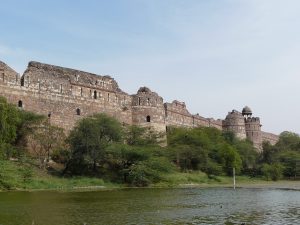(1540 – 55)

- Farid, who later came to be called Sher Khan and subsequently Sher Shah, was son of a Jagirdar under the kingdom of Jaunpur. His father Hasan Khan Sur held the jagir of Sasaram in Bihar during the rule of Lodis.
- After defeating Humayun he became sovereign ruler in the year 1540 and assumed the title of Sher Shah.
- After a gap of 14 years Sher Shah succeeded in establishing the Afghan rule again in India in 1540(Lodis were the first Afghans to rule)
- Sher Shah and his successors ruled for 15 years. This period is known as the period of second Afghan Empire.
- He defeated and conquered Malwa in 1542 which was followed by Chanderi. In Rajasthan he led campaigns against Marwar, Ranthambhore, Nagor, Ajmer, Merta Jodhpur and Bikaner. He defeated rebellious Afghans in Bengal. By 1545 he had established himself as the supreme ruler from Sindh and Punjab to whole of Rajputana in the West and Bengal in the East.
- Now he turned towards BundelKhand. Here while besieging the fort of Kalinjar he died in 1545 in an accidental blast of gun powder.
- After Sher Shah’s death in 1545 his successors ruled till 1555 when Humayun reconquered India.
Sher Shah’s Reforms:
- He made his government highly centralised.
- The king was assisted by important ministers:
Diwan –i- Wizarat – also called as Wazir – in charge
of Revenue and Finance.
2. Diwan-i-Ariz – in charge of Army.
3. Diwan-i-Rasalat- Foreign Minister.
4. Diwan-i-Insha- Minister for Communications. - Sher Shah’s empire was divided into forty seven sarkars. Chief Shiqdar (law and order) and Chief Munsif (judge) were the two officers in charge of the administration in each sarkar.
- Each sarkar was divided into several parganas. Shiqdar (military officer), Amin (land revenue), Fotedar (treasurer) Karkuns (accountants) were in charge of the administration of each pargana.
- Sher Shah had also improved the communications by laying four important highway They were: 1. Sonargaon to Sind 2. Agra to Burhampur 3. Jodhpur to Chittor and 4. Lahore to Multan.
- He extended the Grand Trunk Roadfrom Chittagong in the frontiers of the province of Bengal in northeast India to Kabul in Afghanistan in the far northwest of the country.
- Malik Muhammad Jayasi wrote the famous Hindi work Padmavat during his reign.
- He started building a new walled city in Delhi, which later came to be known as Purana Qila (Old Fort).

- He built his own mausoleum in Sasaram.
